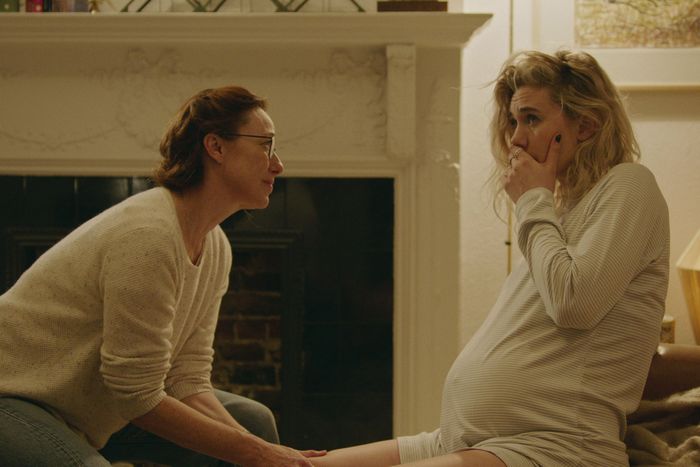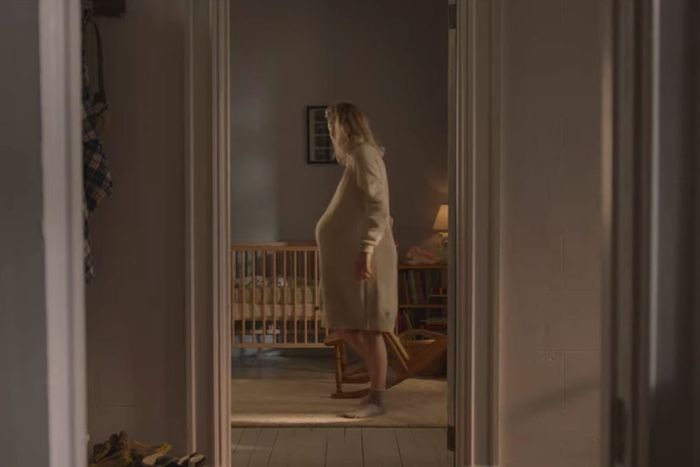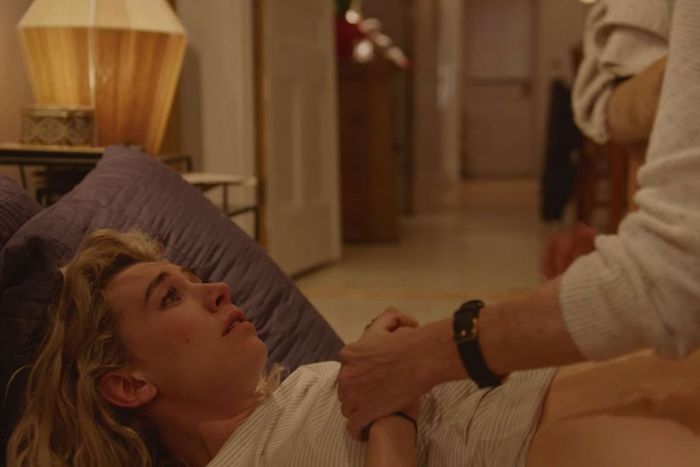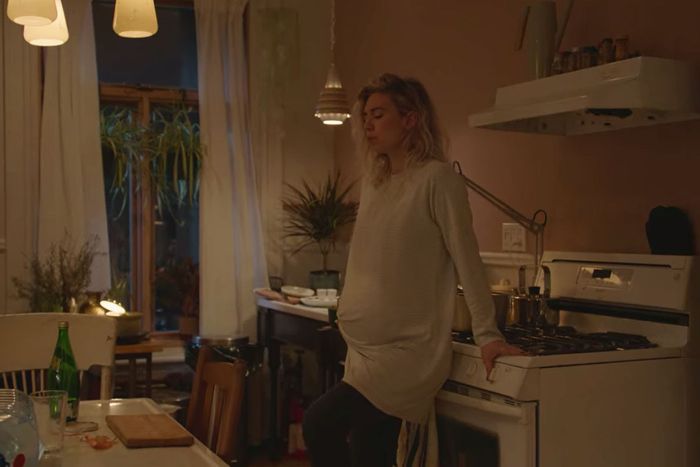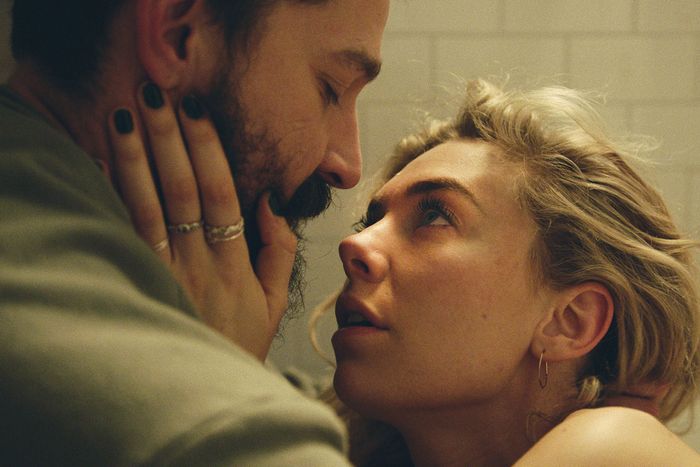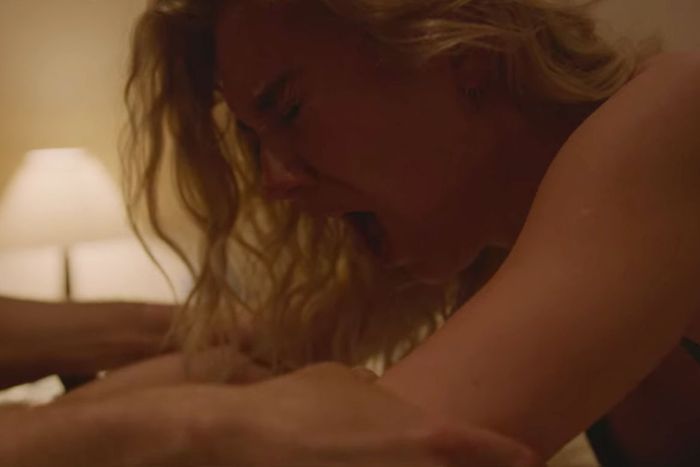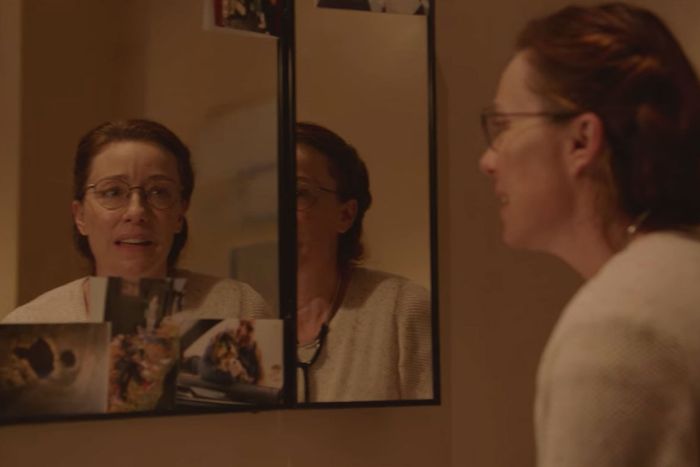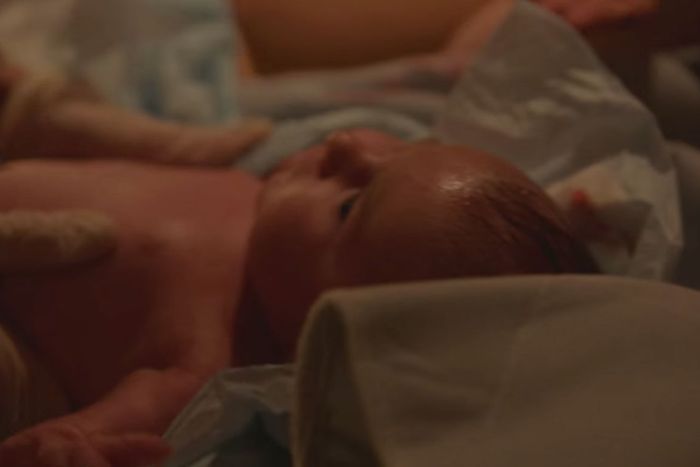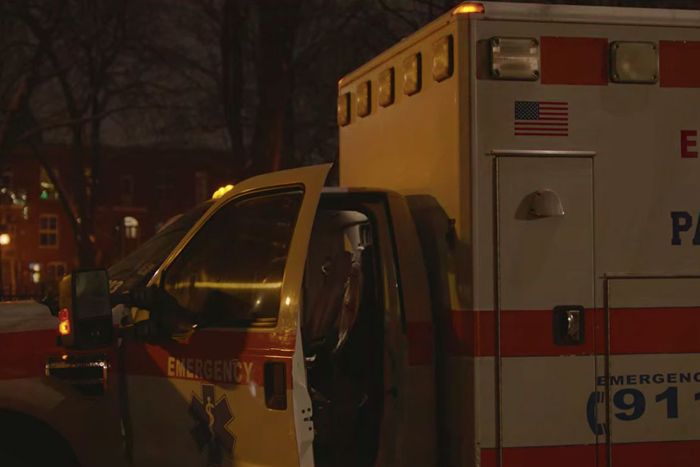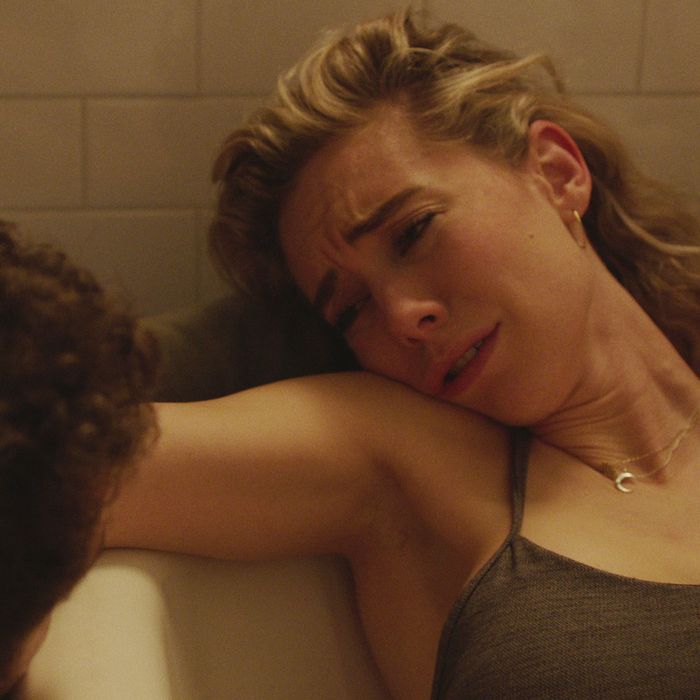
About two-thirds of the way through Pieces of a Woman’s 24-minute, single-shot scene of a home birth with a disastrous end, the midwife, Eva (Molly Parker), decides they need to call 911. “Tell them we have a home delivery and the baby’s in distress,” Eva shouts at the father, Sean (Shia LaBeouf). The baby’s heart rate has slowed after several consecutive contractions, and Eva’s pleasant, bespectacled face contorts with wide-eyed worry. The mother, Martha (Vanessa Kirby), lies back on the bed, mentally curled in a ball. But Sean can’t find the phone. He darts around the apartment, hands in his hair. Find the goddamn phone! my internal voice screamed, before he finally snagged it off the kitchen counter.
Hungarian director Kornél Mundruczó wanted Sean to hunt for the phone, but apparently LaBeouf truly couldn’t find it while filming the take that ended up in the movie. “Probably three of the six takes he forgot where the phone was,” says director of photography Benjamin Loeb, who filmed this scene and the majority of the movie. “Every single time, it was like, ‘Shia, remember where the phone is.’” But Mundruczó relished the “fruitful mistake.” “I really like those moments: Everybody in an emergency, and no one knows what is the next step.”
Chaos, rehearsed and real, is vital to the scene, a depiction of labor and delivery so charged I hunched over and grabbed my abdomen while I watched it, thrust back into memories of my own (unintentionally) unmedicated accouchement. In too much cinema and TV, childbirth scenes are showpieces for the symphony of groaning and grunting an actress can work up. The high drama of childbirth is there in Pieces of a Woman, but it treats delivery like the vulnerable, animalistic, tumultuous ecstasy it is. From the moment her character Martha lets out her first moan until the camera sweeps over her baby’s blue, dying face, this is a series of crescendos and crashes, a shiver-inducing cinematic passage across the River Styx. The single long take is a technical trick, but an emotional lever, too, a reminder that labor is a process you cannot wriggle out of once it has begun.
While LaBeouf’s appearance in the film as Sean has taken on a certain pallor since allegations of his abuse surfaced late last year, Kirby’s performance has been roundly applauded, her name uttered in almost any discussion of the expected Best Actress nominees come March. The backend of Kirby’s character’s story revolves around the legal case against Eva for the baby’s death and Martha and Sean’s discordant, disintegrating marriage. But it’s all anchored to this one heaving, tremendous scene — 24 minutes long, over 30 pages of script, with one free-floating camera and only two days to nab the perfect take.
The Inspiration
In 2010, Hungarian police burst in on renowned gynecologist and midwife Ágnes Geréb at the home of a patient. The raid was perceived to be politically motivated; officials charged Geréb with malpractice and manslaughter for years-old cases in which patients had hemorrhaged and babies had died, in what was seen by many of Geréb’s supporters as an attack on the home-birthing practice in general. (In Hungary, where health care is provided to all citizens, obstetrics is a tightly controlled medical subfield.) “The whole of Hungarian society was shaken by her case,” says Kata Wéber, the Hungarian writer of Pieces of a Woman. It took eight years, a prison sentence, and a ban from her profession before Geréb was granted clemency.
Wéber herself had attended one of Geréb’s trials and talked with the midwife, her lawyers, and the mothers in the case. She planned to write a script about a midwife in a similar situation, but a glimpse of one of the bereaved mothers on Hungarian TV changed her mind. “The only thing I can say,” that mother offered, “is that the midwife did everything possible to save my baby.” Wéber says, “That was the moment, actually, when I decided I’m not going to write a script about the midwife, but I’m going to write a script about the mother, because I felt that this is the sentence of a hero. This is someone who is better than me, is better than us.”
She and Mundruczó, who are married, produced it for the stage in Poland. The film version, which they set in America partly because our litigious cultural landscape meshed with their ideas, “has the same twists and turns. It has the same mood. It almost has the same dialogue.” The play consisted of two scenes — the birth scene and a family dinner, also re-created in the film — and featured contemporaneously filmed projections captured by a cameraman given free rein to wander through the set. It made sense, then, that the birth scene would appear as a single, relentless shot on film. “We really wanted to make sure that the sequence felt like it was presented as a long-winded breath in some ways,” says Loeb, the DP. It’s the longest single-take scene any of them had ever attempted, and it was the first scene they shot for the entire film.
The Setting
Sean and Martha are pacing the floor of their stylish railroad-style Boston apartment — towering windows at each end, large archways separating rooms — when the home-birth scene opens. Although a constructed set would have provided Mundruczó and the camera with more space, Loeb says the director fell in love with an actual apartment that bore a resemblance to what he and Weber built for their stage in Poland. (The kitchen, living room and dining room, says Weber, were in “exactly the same places.”) Luckily, those open archways meant that Loeb could walk freely through the space without hemming the actors into specific corners: “We wanted it to feel like if Vanessa wanted to use the floor, she could use the floor.”
Once the midwife Eva arrives, the characters all move into the living room, and split off to separate areas: Eva to ready the bed for delivery, Martha to the tub, Sean scrambling to find music for his wife and consult with Eva by the dining table. The real difficulty in filming arose when all three actors, Loeb, and two boom operators had to move down the narrow hallway that led to the bathroom and bedroom. “Originally, Mundruczó wanted to go into the bathroom, like, three times,” says Loeb. But the doorway was only 21 inches wide. A mirror directly above the sink opposite would capture his reflection — and thus destroy the whole take, a full 15 minutes into the scene — if he wasn’t careful. Plus, once Loeb stepped into the room behind LaBeouf and Kirby they’d be trapped, unless Mundruczó could backpedal out. So instead, the camera enters the bathroom only once, as Kirby lies in the tub, silent, and follows the length of her body, from her curling hand to her outstretched legs and up past her bulging belly. It dwells on her like an act of reverence.
The Preparation
Mundruczó did not rehearse the scene, save for one walk-through, which Loeb filmed on his iPhone. “If you do a long shot, you have two enemies,” says the director. “If you are very choreographed, then the whole shot can be really cold and calculated. Or the opposite: When you don’t fix anything, it [can] become a Dogme style of shaking camera.”
The walk-through ran to 38 minutes, more than ten minutes past the allotted time. So for their first take, the actors knew they needed to speed everything up. “On one hand, we were very precise, in that sense that, Okay, we need to know that joke has to happen in the kitchen,” says Mundruczó. (The terrible joke Sean tells Martha to loosen her up — “What’s broccoli’s favorite kind of music? Brock and roll!” — came courtesy of LaBeouf, as did the follow-up: “Where does broccoli go to get a drink? At the salad bar!”) But there were literally no marks to hit. Wéber sent Kirby “an enormous amount of material,” including videos of home births, but they never showed the actors video of the stage version for fear it would overly influence their decisions.
“We said we want the perspective of the baby somehow … ” Wéber explains, “a really floaty presence.” A handheld camera turned everything too documentary, “too real,” so Loeb decided to strap himself into a rig vest and film it with a gimbal, a task so physically strenuous he trained for it. “I started out with two minutes on, a minute break, two minutes on, a minute break. Then I bumped it up to four, and then I bumped it on to six, and then I bumped it to ten, and then 12.” (By the third week, he had to see a physical therapist for his “locked glutes.” The day after filming ended, on January 28, 2020, Loeb flew home to Norway and spent 45 days in bed with pneumonia.) Mundruczó, the gaffers, and the producers decided to crowd into the one tiny room in the apartment that the camera never shows us and feed Loeb some direction through an earpiece.
“We had a path” says Loeb. “We needed to stick to the path in terms of timing. But within that, it was just feeding off of the energy that was happening in front of the camera.”
The Labor
Mundruczó and Wéber settled on the fourth of their six takes in the crowded apartment. The one they chose (the last shot on the first day of filming) is technically a little messy — if you look carefully you can see LaBeouf and Loeb collide briefly in the hallway — but the two “perfect” shots filmed the second day were, according to Mundruczó, “less miraculous and less alive.”
Martha’s labor is abbreviated here, sixteen hours crammed down into 24 minutes. But just as real contractions do, the scene crescendoes and collapses. There are no sanitized blue hospital drapes or feet stuck in stirrups. Things get primal. Writhing on the living room floor in the swell of a fierce contraction, Martha rolls over and bites Sean’s calf. Hard. Kirby says, with a little astonishment at herself, that LaBeouf had no idea she was going to do it — “God, no. It just happened.” She had noticed how frequently women in labor would “try [to] share the pain.” Loeb’s grip had to grab hold of the DP’s vest and gently hoist him off the floor afterward; his rig was too heavy to stand with.
“It so terrified me, the idea of getting it wrong, because so many women would watch it who had done it,” says Kirby, who does not have any children. So she spent long days in a maternity ward with midwives, “who were showing me the positions and telling me about each moment and scientifically taking me through every single second of labor.” One laboring woman she observed was heavily nauseous, which inspired Kirby to start burping — and then profusely apologizing — in character. “I just tried to imagine that was happening to me,” she says. “I had no idea it was going to result in burps but that’s what happened in the moment, embarrassingly.”
The Shift
Martha insists she’s too weak to walk. A small trickle of blood ribbons through the tub water. Wéber lays a line of breadcrumbs like these — things you might reflect on in the aftermath and wonder if they were foreboding or simply part of the mess of human procreation. And then the baby’s heart rate drops.
“They really wanted to establish this moment, where you can hardly decide, or you will hardly remember, what happened there,” says Wéber. Eva rifles through a binder and tells Sean that if the heart rate doesn’t come back up they may need to transfer Martha to the hospital. The weight of responsibility shifts silently from person to person. Eva is the medical expert, but Sean is the father. “We’re okay though?” Sean asks. Eva pauses, swallows, her eyes dart around: “Yeah, we’re good.”
“[Actress] Molly was amazing with this,” Wéber says. “I think it’s her initiative to really express this ambivalent moment, where you can see on her face there are so many things inside, but what she says, it’s almost nothing.”
After urgent directives to Martha to push, to “get this baby out right now,” the child slides into the world, slimy and silent at first and then blessedly massaged into a squall. For a brief moment, the new little family huddles together; Sean pulls out a camera.
Mundruczó didn’t want to use a prosthetic baby, and inserting a secondary shot would spoil the fluidity of the take. So a mother (“a great, great French woman,” Mundruczó tells me earnestly) waited with her five-week-old baby just outside the apartment. The baby was quickly whisked into the room while the camera focused on Martha and Sean. The only CGI was for the umbilical cord. Kirby says having a real baby in her arms was crucial. “The baby being there and her looking at me was just … I couldn’t have acted the rest of the movie without her.”
We barely see the baby (called Yvette, we later learn, as her parents consult with the headstone company) after that, but for the slightest glimpse when Eva, who is shaking off the adrenaline, catches sight of her pink flesh turning blue. Mundruczó says, “As an ethical question, I felt that I just cannot do it. I just cannot do more. I’m not able to show a baby dying onscreen.” The effect is more, rather than less, emotional. The camera catches Martha as the baby is ripped from her — her arms full of motherhood one minute, empty the next. And then it follows barefoot Sean at a sprint down the hall and outside into the cold Boston winter to the arriving ambulance. We know the baby dies, but after what feels like a never-ending, direct line of sight, we’re stranded outside, watching the blue and red lights flicker, eerie twins to Sean’s flashing camera.
According to Mundruczó, this was always the plan for the scene, but Loeb says they shot it two ways. In the other, the camera stayed with Martha. “There was a conversation between Kornél and I and the actors: Was it almost too harsh and too hard to be stuck in that moment with Martha’s character?” Wéber says it wasn’t her goal to write a tragic birth scene. “I wanted to write about the spiritual energy, ” she says, “how you meet with something that you don’t know how to meet with: the unknown.”
When the scene ended, Mundruczó says, Kirby began to cry. “And we hugged each other, like … I don’t know. I mean, maybe I expand time, but long. More than 15 minutes, really hugging each other.”


